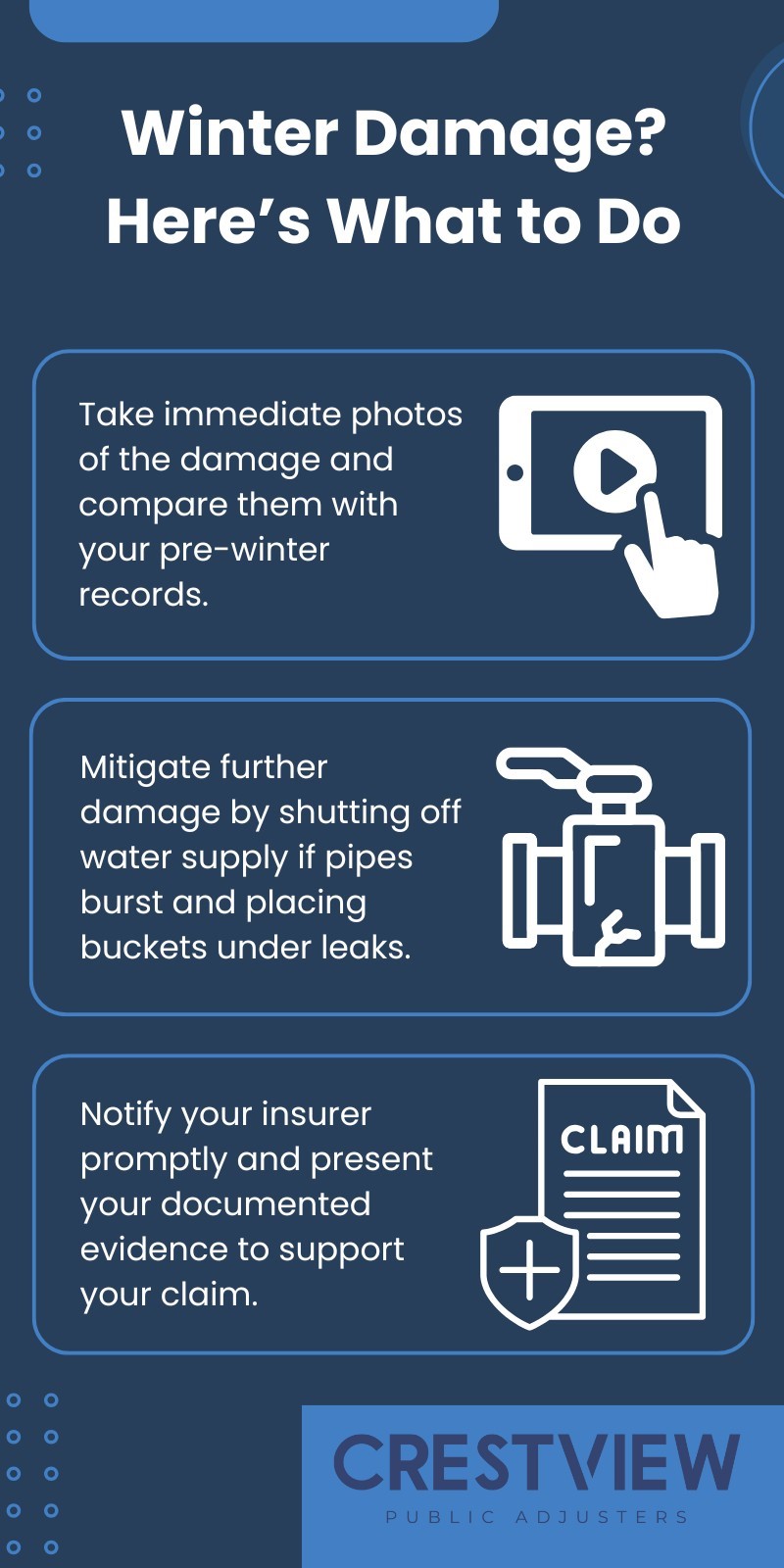Key Points:
- Properly documenting your home’s condition before winter can provide crucial evidence for insurance claims.
- Homeowners should focus on structural integrity, roofing, insulation, and plumbing to prevent costly damages.
- Public adjusters can help policyholders navigate winter damage claims and secure fair settlements.
Documenting your home’s condition before winter is essential for insurance protection and damage prevention. By keeping thorough records of your home’s state before the cold season, you create undeniable proof of pre-existing conditions. This can help in filing insurance claims for winter-related damages, such as roof leaks, frozen pipes, and structural issues caused by heavy snow or ice. Without proper documentation, insurers may deny or undervalue claims, leaving homeowners with hefty repair bills.
Why You Should Document Your Home’s Condition Before Winter
Winter can be brutal on homes, with freezing temperatures, heavy snow, and ice buildup causing structural and water damage. According to the Insurance Information Institute, winter storms caused $2.1 billion in insured losses in the U.S. in 2022. Many of these damages could have been covered fully or partially if homeowners had documented their property conditions before winter.
Insurers often require solid proof that damage was caused by a storm rather than poor maintenance. Without pre-winter documentation, they may argue that pre-existing issues—such as loose shingles or weak insulation—contributed to the problem. By keeping a detailed record of your home’s condition, you protect your ability to secure fair compensation for covered losses.
What Should You Document Before Winter?
1. Roof and Gutter Condition
The roof is your home’s first line of defense against winter storms. Even minor roof damage can worsen when exposed to heavy snow and ice. Before winter, inspect and document:
- Shingle Condition: Take photos of any missing, loose, or curling shingles.
- Flashing and Seals: Check around chimneys, vents, and skylights for cracks or gaps.
- Gutter System: Ensure gutters are clear of debris and securely attached. Document any weak or sagging sections.
Without proper documentation, insurers may claim that roof damage was pre-existing and deny coverage.
2. Plumbing and Pipe Insulation
Frozen pipes are one of the most common causes of winter water damage. A burst pipe can cause thousands of dollars in damage within minutes. To document your plumbing:
- Take photos of exposed pipes in attics, basements, and exterior walls.
- Check for existing leaks and photograph any areas of concern.
- Ensure insulation is intact and clearly document wrapped or heated pipes.
This evidence proves that pipes were in good condition before winter, strengthening your claim if damage occurs.

3. Foundation and Exterior Walls
Cold weather can worsen small cracks in your foundation and walls. Before winter:
- Inspect and document any cracks in the foundation and siding.
- Take photos of windows and doors to prove they were properly sealed.
- Note any water stains or moisture buildup that could signal future damage risks.
If new cracks or leaks appear during winter, having before-and-after evidence will help confirm they resulted from seasonal changes.
4. Heating System and Chimney
A functioning heating system is critical during winter. Before temperatures drop:
- Take photos of your furnace or boiler and keep a record of recent maintenance.
- Document chimney and fireplace conditions to show they were intact before winter.
- Check for soot buildup or damage and photograph the chimney cap to prove it was secured.
In the event of a heating system failure or chimney-related damage, having this documentation strengthens your case for insurance reimbursement.
How to Properly Document Your Home’s Condition
1. Take High-Quality Photos and Videos
Capture wide-angle shots and close-ups of key areas, including the roof, siding, windows, plumbing, and heating systems. Make sure the date and time are recorded.
2. Keep a Written Record of Inspections
Write down observations about your home’s condition, including any minor issues found. Even small concerns, like hairline cracks, should be noted.
3. Save Repair and Maintenance Receipts
If you’ve recently repaired or upgraded any part of your home, keep records. These can prove that your home was in good condition before winter.
4. Conduct a Final Walkthrough Before the First Snowfall
Before the first snowfall, do a complete walkthrough of your property. This ensures no last-minute issues go undocumented.
What to Do If Winter Damage Occurs
Even with thorough documentation, winter can still cause unexpected damage. If you experience leaks, ice dams, or burst pipes:

Many insurance companies try to minimize payouts by claiming damages were due to poor maintenance. Your detailed records can counter these arguments.
Get Help with Your Winter Damage Insurance Claim
Winter damage claims can be complex, and many homeowners struggle to get the full compensation they deserve. Crestview specializes in handling winter-related insurance claims for policyholders in New York, New Jersey, and Florida.
With extensive experience in public adjusting, we help homeowners gather evidence, negotiate with insurers, and maximize their settlements. If you’ve suffered winter damage, don’t navigate the claims process alone. Contact Crestview today and let our experts fight for the coverage you deserve.

